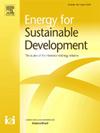Research on the characteristics and influence factors of residential building energy usage patterns: A case study in Beijing
IF 4.4
2区 工程技术
Q2 ENERGY & FUELS
引用次数: 0
Abstract
With the increase demand on electricity for urban residential living, compounded by factors such as frequent extreme weather events, residential electricity demand has significantly risen. This study did the investigation on building energy consumption habits of residents in Beijing urban areas, combined with real residential electricity bills acquired through State Grid Corporation of China, to explore the energy usage patterns and influence factors. By questionnaire statistics, households were divided into 6 categories and the electrical appliances usage characteristics and energy consumption levels were analyzed. The research identified urban residents' living habits and electricity usage, revealing significant quantitative relationship among electricity consumption, family structure, economic level and so on with principal component analysis (PCA). The analysis of household electricity consumption showed that households simultaneously including workers, school students, and people who usually stay in homes (e.g. retired, unemployed) had the highest average annual energy consumption at 4226 kWh/household, which was 1134–1625 kWh/household higher than homes without members staying in during office hours. The combination of air conditioners (ACs) and electric fans is found to be commonly used in residential buildings, and this method is highly effective in energy conservation. Additionally, it is indicated that 46.5 % of residents were willing to participate in the strategy of flexible energy use. Amidst the comprehensive electrification trend in buildings, this study is of great significance for energy conservation, emission reduction, and demand-side management.
住宅建筑能源使用模式特征及影响因素研究——以北京市为例
随着城市居民生活用电需求的增加,再加上极端天气事件频发等因素,居民用电需求大幅上升。本研究通过对北京城区居民建筑能耗习惯的调查,结合国家电网公司获取的真实居民电费账单,探讨其能源使用模式及影响因素。通过问卷统计,将住户分为6类,分析家电使用特点和能耗水平。研究确定了城市居民的生活习惯和用电量,利用主成分分析(PCA)揭示了用电量与家庭结构、经济水平等之间的显著定量关系。对家庭用电量的分析显示,同时包括工人、学生和通常在家的人(例如退休人士、失业者)的家庭的年平均用电量最高,为4226千瓦时/户,比没有成员在办公时间在家的家庭高1134-1625千瓦时/户。空调与电风扇相结合是住宅建筑中常用的一种方式,这种方式节能效果显著。此外,46.5%的居民愿意参与灵活能源使用策略。在建筑全面电气化的大趋势下,本研究对节能减排和需求侧管理具有重要意义。
本文章由计算机程序翻译,如有差异,请以英文原文为准。
求助全文
约1分钟内获得全文
求助全文
来源期刊

Energy for Sustainable Development
ENERGY & FUELS-ENERGY & FUELS
CiteScore
8.10
自引率
9.10%
发文量
187
审稿时长
6-12 weeks
期刊介绍:
Published on behalf of the International Energy Initiative, Energy for Sustainable Development is the journal for decision makers, managers, consultants, policy makers, planners and researchers in both government and non-government organizations. It publishes original research and reviews about energy in developing countries, sustainable development, energy resources, technologies, policies and interactions.
 求助内容:
求助内容: 应助结果提醒方式:
应助结果提醒方式:


